(June 2011) If you are looking for information on the newer Phottix Strato II Multi Trigger, please have a look here.
The Strato 4-in-1 Trigger is a brand-new product from Phottix. It is a 2.4GHz 4-channel wireless flash trigger that can also be used as wired or wireless shutter release, and uses commonly-available AAA batteries.
Some of the key features that make this trigger appealing include remote flash wake-up capability, and a TTL pass-through hotshoe on the transmitter.
It's important to understand that the Strato 4-in-1 Trigger does NOT provide wireless TTL support. Any flashes triggered wirelessly by the Strato 4-in-1 Trigger must be in manual mode.
It can also be used as a wired or wireless remote shutter release, but it only provides fairly basic shutter release functionality.
Thanks to Phottix for providing a pre-release version of the Strato 4-in-1 Trigger (Canon-compatible version) for review purposes. They provided me with one transmitter, two receivers, and some PC Sync cables. Also thanks to Steve at Phottix for responding to my many questions about the Strato 4-in-1 Trigger.
Note that Phottix have previously sold a wireless remote called the "Strato" that provided remote shutter release functionality and flash trigger functionality. This new trigger is officially called the "Strato 4-in-1 Trigger", and is a completely separate product from the old "Strato".
This re-use of the "Strato" name may cause some confusion, so I have made a point of using the full name of "Strato 4-in-1 Trigger" in this post.
Features
The Strato 4-in-1 Trigger provides the following functionality:
- 4 channels (transmitter can trigger a single channel, or all channels simultaneously)
- wireless flash trigger
- TTL pass-through
- remote flash wake-up
- wired shutter release
- wireless shutter release
Specifications
| Frequency | 2.4 GHz |
| Range | 100 metres + |
| Channels | 4 |
| Batteries |
2 x AAA in receiver and transmitter,
5V DC socket for external power supply on receivers |
| Max sync speed (1) | 1/250 sec |
| Transmitter inputs |
hot shoe,
3.5mm socket (PC Sync) |
| Transmitter outputs | hot shoe (TTL pass-through) |
| Receiver inputs | socket for external 5V DC power |
| Receiver outputs |
hot shoe (for triggering flash),
3.5mm socket (PC Sync), 2.5mm socket (shutter release) |
| Transmitter dimensions | 85 x 40 x 38 mm (LxWxH) |
| Receiver dimensions | 85 x 40 x 31 mm (LxWxH) |
| Minimum response time (2) | 400 us |
| Maximum flash trigger voltage (3) |
5V for transmitter hotshoe
300V for receiver hotshoe |
| 1. | Dependant on camera and flash capabilities. |
| 2. | Refers to time between pressing transmitter button and flash attached to receiver being fired. |
The polarity of the 5V DC socket on the Strato 4-in-1 receivers is not indicated on the receiver itself, but Phottix have confirmed the centre pin is positive, and the outer shell is negative.
Phottix have confirmed that they will have Strato 4-in-1 Trigger models available to suit Canon TTL and Nikon TTL (and more recently also Sony).
(Because of different TTL pinouts and protocols used by different camera manufacturers, the Strato 4-in-1 transmitter TTL pass-through functionality is specific to a specific camera brand.)
The Strato 4-in-1 Trigger triggers for Canon can be used to trigger Canon and 3rd party Canon-compatible TTL flashes via the transmitter's pass-through hotshoe. The Strato 4-in-1 receivers can be used to trigger any regular centre-fire flashes, as well as studio strobes.
A brand-specific version of the receiver is likely to be required for remote flash wake-up functionality (ie, a Strato 4-in-1 receiver for Canon is likely to be required to wake up Canon-compatible flashes).
When using the Strato 4-in-1 Trigger as a wired or wireless shutter release, you will need the appropriate shutter release cable to suit your camera.
Transmitter
The Strato 4-in-1 transmitter has a metal hotshoe for mounting in a camera hotshoe, and also has a hotshoe on the top of the receiver, which supports TTL pass-through.
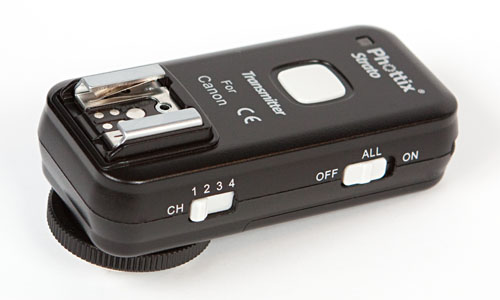
A four-position channel switch allows you to select the channel to be used, and the other two-position allows you to configure the transmitter to trigger just the receivers configured to the same channel (when in position "OFF"), or trigger receivers on all channels (when in position "ON").
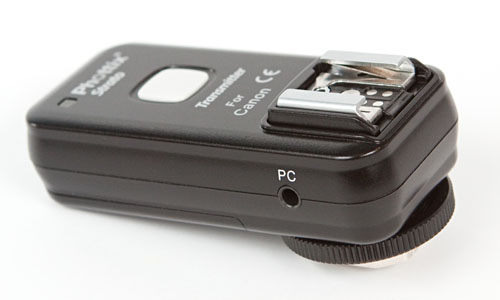
The transmitter also has a 3.5mm PC sync socket, which allows it to be triggered via a PC sync cable (although you'll lose the TTL pass-through functionality of course).
The large button on the transmitter provides test functionality, and will trigger the receivers.
Note that the transmitter does not have a power switch.
Receiver
On one side of the receiver, you'll find a power switch, and a four-position channel selection switch.
The large button on top of the receiver only is used when operating the receiver as a wired shutter release.
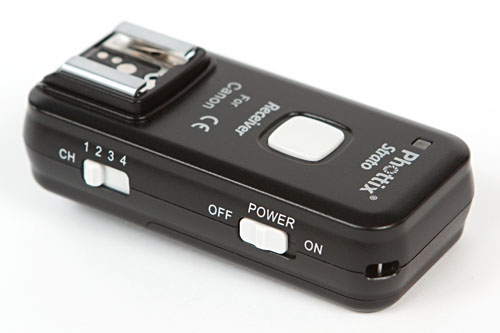
The Strato 4-in-1 receiver sports a hotshoe on the top, for connecting a flash. The "FLASH" socket accepts a 3.5mm PC sync cable, providing another option for connecting a flash.
The "DC5V" socket accepts 5V DC from an external power supply (centre pin is positive), and could be useful in a studio environment, rather than relying on battery power.
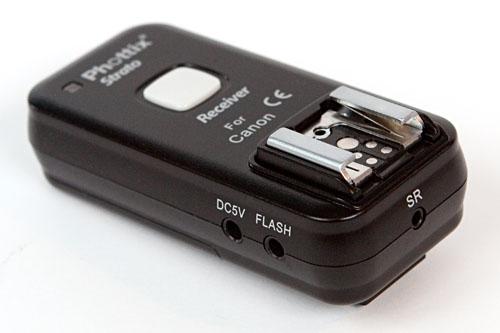
PC sync socket (FLASH), and shutter release socket (SR)
The hotshoe on top of the receiver features a full TTL pin-out, which is used to provide remote flash wake-up capability.
The 2.5mm "SR" socket on the receiver accepts a shutter release cable, allowing the receiver to be used as a wired shutter release, or a wireless shutter release.
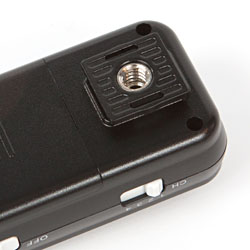
|
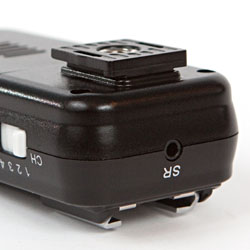
| |
|
Strato receiver, showing cold shoe mount and 1/4" socket
| ||
The underside of the receiver has a cold shoe, with a 1/4" metal-threaded socket, providing multiple options for mounting a receiver on a light stand or tripod.
More photos of the Strato 4-in-1 Trigger are available in this photo gallery.
Wired Shutter Release
The Strato 4-in-1 receiver can be used as a wired shutter release by connecting an appropriate shutter release cable between the receiver and your camera. The large button on the receiver functions as a dual-stage shutter button, allowing you to trigger the camera's shutter.
Only basic remote shutter functionality is provided - there is no support for bulb mode (unless you are prepared to hold the Strato 4-in-1 receiver's button down).
Note that there is no need to power on the receiver when using it as a wired remote.
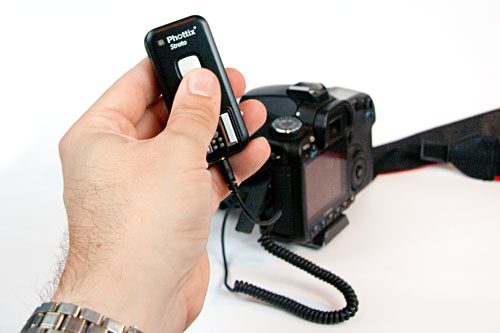
Wireless Shutter Release
To use the Strato 4-in-1 Trigger as a wireless shutter release, connect an appropriate shutter release cable between the receiver and your camera, and turn on the receiver. With the transmitter set to the same channel (or all channels), the large button on the transmitter serves as a remote shutter release.
The receiver can be optionally inserted into your camera's hotshoe, rather than leaving it dangling from the shutter release cable.
There is no support for bulb mode, delayed shutter triggering, or multiple exposures. If you require more advanced wireless shutter release functionality, have a look at the Cleon II or the Plato.
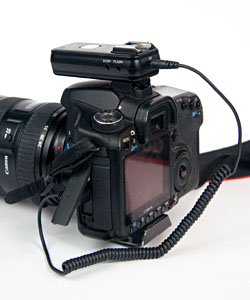
|
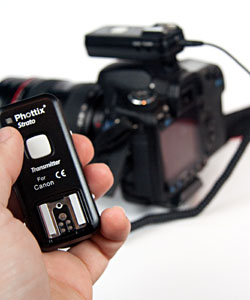
| |
|
using the Strato Trigger as a wireless shutter release,
with receiver connected to camera via shutter release cable (left image), and transmitter used to remotely trigger the shutter (right image) | ||
Flash Trigger
With the Strato 4-in-1 transmitter on a camera's hotshoe, it will trigger any remote flashes connected to Strato 4-in-1 receivers that are set to the same channel. The transmitter's test button will trigger any receivers on the same channel, as well as any device on the transmitter's hotshoe.
A Canon ST-E2 or Canon-compatible flash can also be mounted on the Strato 4-in-1 transmitter's hotshoe. The TTL pass-through functionality of the Strato 4-in-1 Trigger means the camera will see the ST-E2 or flash as if it is mounted directly in the camera's hotshoe, with full TTL communications provided.
With an ST-E2 mounted on the transmitter, the transmitter's test button is not accessible.
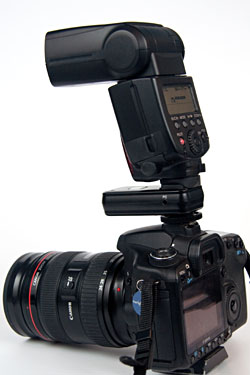
580EX II flash on Strato transmitter
|
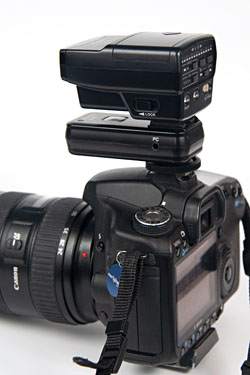
Canon ST-E2 on Strato transmitter
|
Alternatively, the Strato 4-in-1 transmitter can be connected to a camera via a PC sync cable (but you will lose the TTL pass-through functionality of course), and actuating the camera shutter will cause the transmitter to trigger any remote receivers.
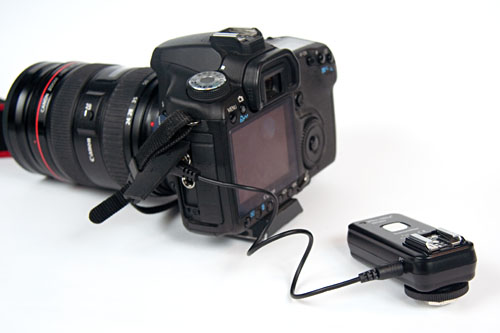
The hotshoe on the top of the Strato 4-in-1 receiver allows a flash to be attached, and the receiver will trigger this flash when signalled by the transmitter.
The Strato 4-in-1 receiver can be mounted either using the plastic hotshoe mount (as per photo below on the right), or using the 1/4" threaded socket (as shown in photo below on the left).
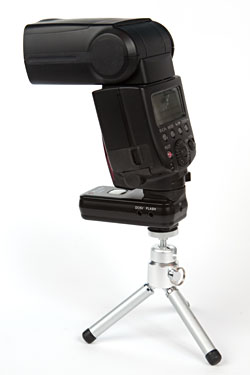
Strato receiver and flash on mini-tripod
|
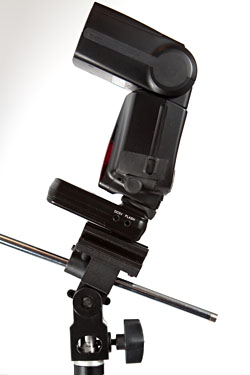
Strato receiver and flash on a light stand
|
Alternatively, a flash can be connected to a Strato 4-in-1 receiver via a PC sync cable.
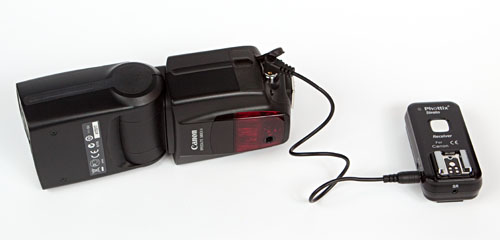
Remote Flash Wake-up
The Strato 4-in-1 receivers will wake up any TTL flashes that are attached to their hotshoe. This can be done either by hitting the test button on the transmitter, or by doing a half-press of the camera's shutter button, both of which will trigger the receiver to wake up the attached flash.
Flash Trigger Sync Speed
The Strato 4-in-1 Trigger specifications indicate a maximum flash sync speed of 1/250 seconds, depending on camera and flash capabilities.
A few test shots with a Canon 50D body and a Strato 4-in-1 Trigger triggering a Canon 580EX II flash in manual mode confirms that the Strato 4-in-1 Trigger can achieve full sync at 1/250 seconds, and as expected, only partial sync is possible at faster shutter speeds, as shown in the photos below.
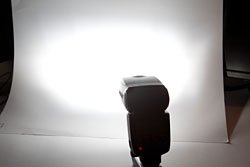
full sync at 1/250 sec
|
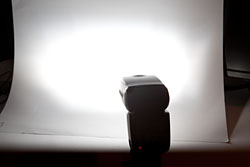
partial sync at 1/320 sec
| |
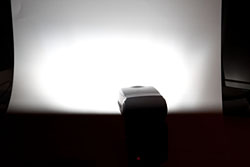
partial sync at 1/400 sec
|
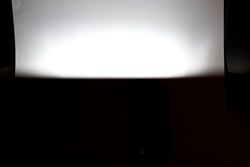
partial sync at 1/500 sec
| |
I was impressed by the build quality of the Strato 4-in-1 triggers. The quality of the camera accessories coming out of China has definitely improved over the last few years, and the Strato 4-in-1 Trigger cases are well-made with good quality plastic, and feel very robust.
The switches on both the transmitter and receiver are much easier to use than the tiny dip switches seen on many other triggers.
I like the size and shape of the receivers, as the relatively thin size allows a flash to be mounted on an umbrella stand without moving it too far from the umbrella centre.
Use of AAA batteries is a big benefit, as they are cheap and more readily available than batteries used by some other flash triggers.
The TTL pass-through support on the transmitter is very useful, allowing TTL devices to be mixed with other flashes triggered by Strato 4-in-1 receivers. Alternatively, in low light situations, in addition to the Strato 4-in-1 transmitter on the camera's hotshoe, you can also have a flash or ST-E2 on the camera's hotshoe, just for the focus-assist light.
The remote flash wake-up capabilities of the receivers is another very useful feature, as it allows you to easily wake up all your remote flashes if they have gone to sleep.
Initial testing indicates the triggering of the Strato 4-in-1 Triggers is reliable, with no mis-fires observed. I'll have to do some further testing of the range in the future.
The Strato 4-in-1 Trigger's functionality as a wired shutter release or wireless shutter release is somewhat limited, with no support for bulb mode, delayed triggering or multiple shutter actuations. However, it can be useful, as the Strato 4-in-1 Trigger allows you to have a single device in your camera bag that can be used as either a shutter release or a flash trigger.
The Strato 4-in-1 Trigger is now available for purchase from phottixstore.com.
The following Strato options are available:
- Strato Recceiver + Transmitter (for Nikon, Canon or Sony) for USD$73.94 (AUD$81.13)
- additional Strato Receiver for Nikon for USD$51.59 (AUD$56.60)
- additional Strato Receiver for Canon for USD$51.59 (AUD$56.60)
- additional Strato Receiver for Sony for USD$51.59 (AUD$56.60)
- C6 - for Canon 350D/400D/450D/500D/550D/1000D/60D/G10
- C8 - for Canon 20D/30D/40D/50D/7D/5D/1D
- N10 - for Nikon D90/D5000/D7000/D3100
- N6 - for Nikon D70S/D80
- N8 - for Nikon D200/D300/D700/D2Xs/D3, Fuji S5
- S6 - for Sony A100/A200/A300/A350/A700, Minolta 5D/7D
Update (01 June 2011): Phottix have now released a new and improved flash trigger called the Strato II Multi. It provides the same functionality as the Strato 4-in-1, but adds some new features and functionality, while still being backwards compatible with the Strato 4-in-1.
Read my review of the Strato II Multi.
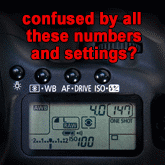


Excellent review. All the information I wanted and more. Wish all reviewers are as comprehensive and detailed as you. And best of all, no time-wasting waffling, digressing and BS.